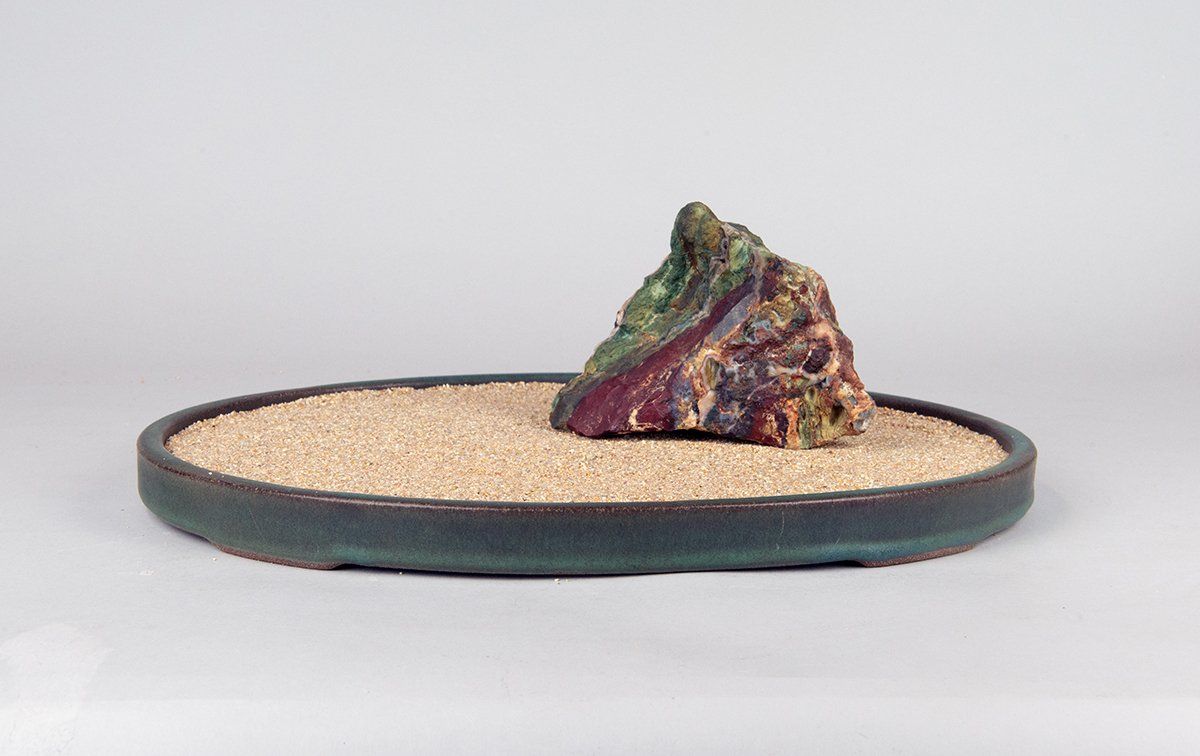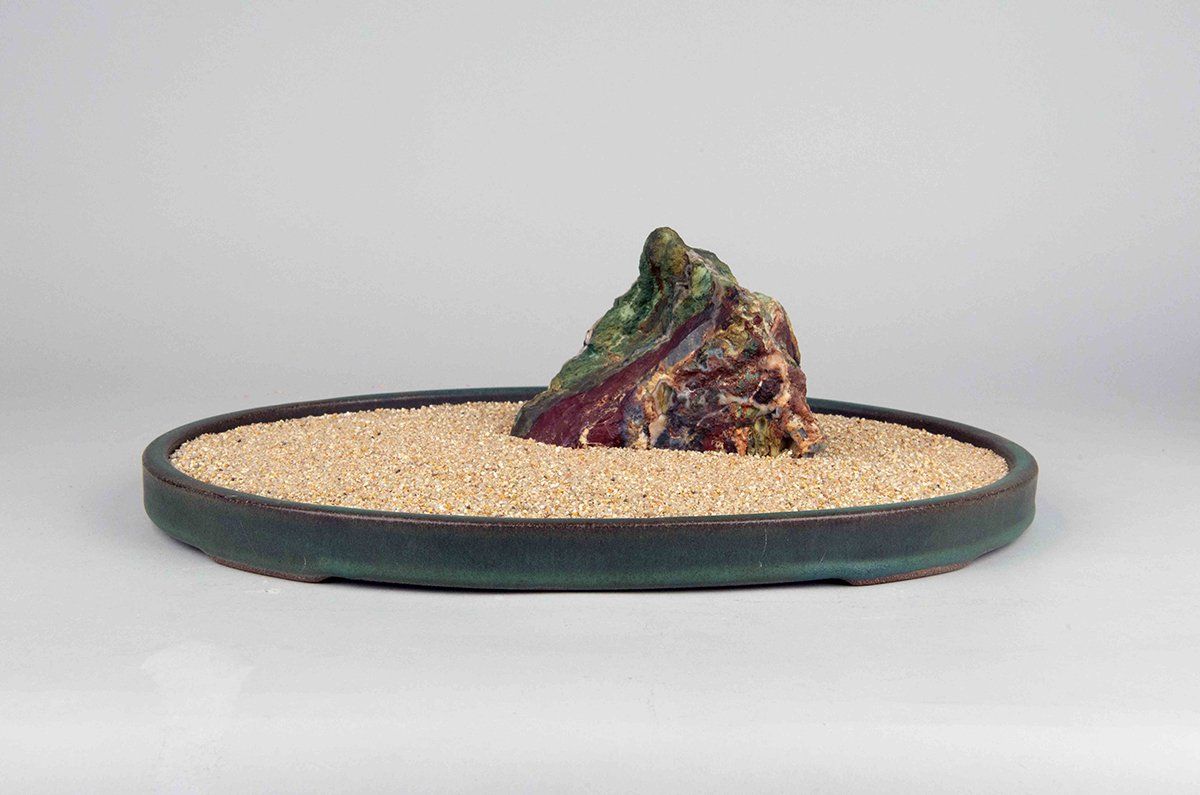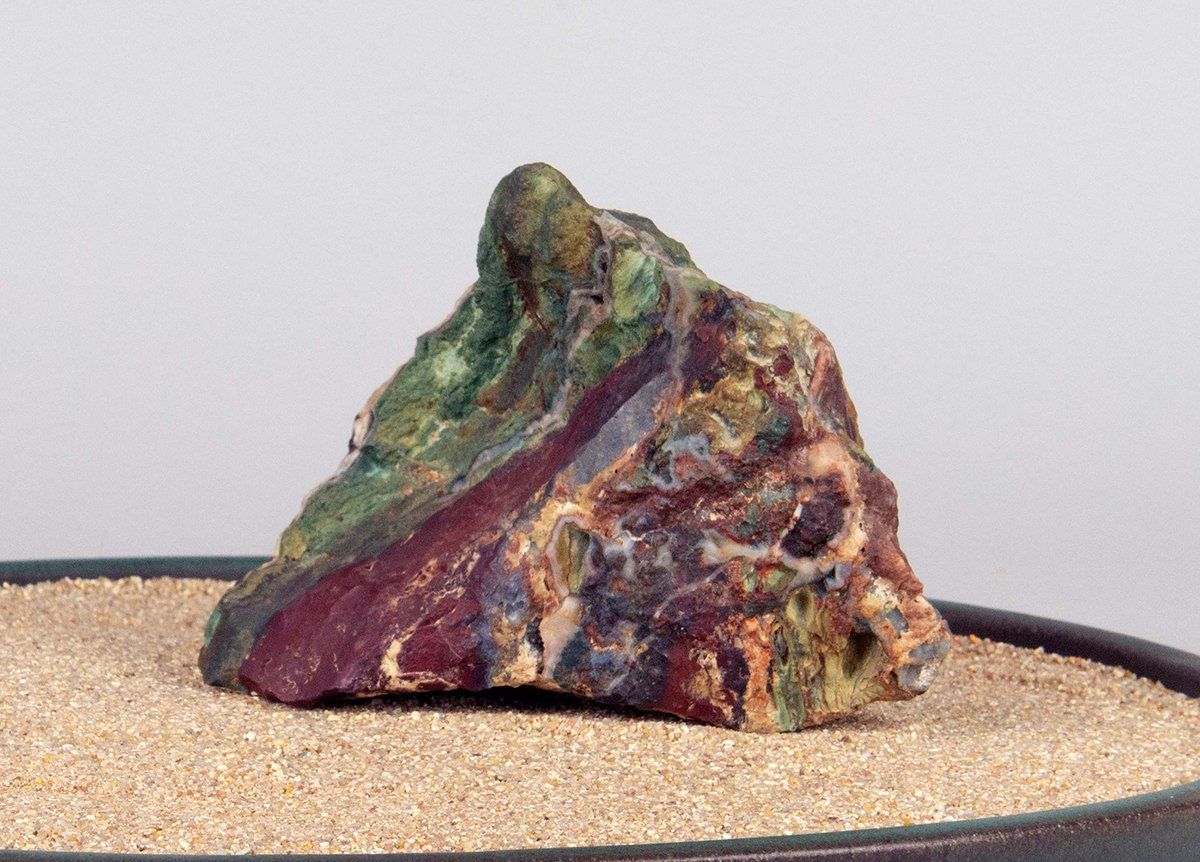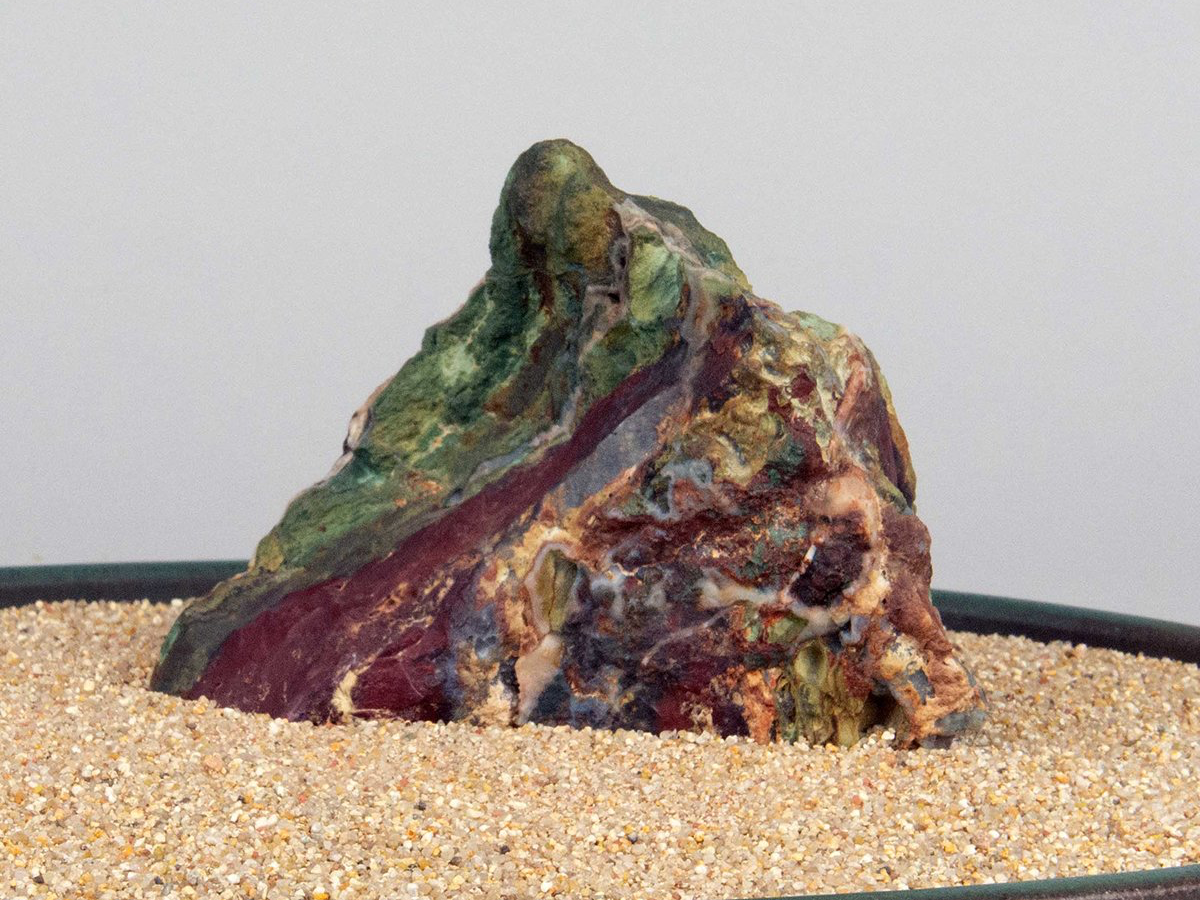The Role of Trays in Viewing Stone Displays, Part 2
A detailed discussion of how to orient and place stones in ceramic and metal trays used in mainly Japanese stone appreciation displays.
By Thomas S. Elias, and Hiromi Nakaoji, April, 2021
Part two is a detailed discussion of matching stones with trays, sand in trays, and positioning stones in trays.
The process of selecting and matching a suitable tray (suiban) with a stone is challenging. It is primarily a practice initiated and refined by Japanese stone connoisseurs and later adapted by Chinese and other Asian and western collectors. Murata Keiji provided detailed information about the selection of the suiban and how to place stones in trays in his book How to Place and Display Suiseki (1966). In that volume, Murata illustrated several options for displaying suiseki in different situations outside the traditional tokonoma, an alcove for displaying art.
The use of suiban in stone displays received a significant boost from Katayama Teiichi and his school of Keido which taught methods of display. Katayama encouraged the use of suiban and fostered a return to traditional values and methods of display. He discussed the use of trays in his book Appreciation of Suiseki (1971) and produced many photographs showing how to use suiban in displays in Tree Pots, Suiban, and Selected Items (1986). Katayama stated that natural stones can become suiseki once they are in suiban, and that some stones can become suiseki when placed in daiza.
Matsuura Arishige, former chairman of the Nippon Suiseki Association, provided further guidance for the use of trays in his, An Introduction to Suiseki (2010). Matsuura wrote that suiban are best used for stones associated with water (pools, waterfalls, islands, coastal scenes). He discourages the use of suiban in winter and thinks they are better suited for warmer seasons.
The use of trays involved several important factors that influence the tray’s selection: shape, color, depth, and tray ornamentation or patterns. These factors will be treated via series of questions.
When should I use an oval-shaped tray instead of a rectangular one?
The distinction between the two is not significant, and you can sometimes use either shape successfully. Most collectors do not have a variety of trays to use. The choice of a tray depends mainly on what you hope to accomplish with your display. An oval tray evokes a feeling of openness and unlimited boundaries. In contrast, a rectangular tray with its sharply defined corners that provide a sense of confinement with their sharp demarcation of boundaries. Experienced stone collectors generally prefer to use oval trays for exhibiting their stones. Compare the following two displays that use the same rock but different shaped trays. They are produced here in black and white to eliminate color in influencing your opinion.
What are the correct proportions of stone and tray to use?
Murata Keiji (1966) provided the 2:3 ratio for determining proportions of stone to the tray as a guideline. If the stone is 40 cm wide, the suiban should be about 60 cm wide to obtain a balance between the two elements. Some western stone enthusiasts have interpreted this as a rigid rule, but it should be considered an approximation. Much depends upon what you are trying to accomplish with the display. For example, if you want to create the sense of a small boat in a vast body of water, then a boat-shaped stone in large
suiban with a ratio of 1:3 or 1:4 can be used. The impression of a near-by massive rocky outcrop can be is achieved by devoting more space to the stone. Avoid extremes as the balance and harmony between the stone and tray is most important.
How important is matching the color of the tray with the color of the stone?
The colors of a tray and stone should be complementary and harmonize with each other. Choosing a tray with a contrasting color is more difficult to achieve without drawing attention away from the stone.
The colors in the Australian banded hematite stone and copper tray harmonize and complement each other. Generally, seek to find compatible colors rather than strongly contrasting colors. Brightly colored trays often compete with the stone for the viewer’s attention. Thus, most collectors prefer trays with subdued colors and copper alloy trays with
an aged appearance. Traditionalists may find this copper tray and banded hemitate too colorful to be called suiseki, but suitable for a viewing stone.
What type of sand and how do I use?
Today, most stones are displayed with sand in the trays. However, if you are creating the impression of an older historical display or a more contemporary approach, the stone can be displayed in the tray without sand. At one time, water was used in trays, but this is becoming less frequent due to practical issues. Some collectors regularly mist their stone when displayed in a tray and watch the patterns of the water drying on the stone.
Untreated, natural sand occurs in many colors with varying shades of brown and tan. White, pink, green, and black sand also occur but are not common. The color of the sand depends upon the type of rocks and minerals that was broken down into sand-sized particles. Technically sand is particles that are 0.074 and 4.75 mm and is categorized as fine, medium, and coarse-grain sand.
Sand represents either water or land in a display. It is conceivable that it could also represent space in more imaginative displays.
Sand used in viewing stone displays should be uniform in color and size, if possible. Avoid multi-colored natural sands and artificially colored sands. Neutral-colored sands (tan, golden brown, light brown, and beige) are best. White sand is typically too bright and contrasts too much with the stone. Matsuura wrote that fine-grained sand can be used with stone with a smooth surface and more coarse-grained sand is suitable for stones with rough-textured surfaces. The sand should also be clean to eliminate small pieces of leaves, twigs and other tiny foreign objects.
Current guidelines for traditional displays call for sand to fill the tray to the point below the tray’s rim. Matsuura (2010) recommended filling a tray to 90 to 95% capacity. Decades earlier in Japan, collectors did not fill trays with as much sand as is seen today. Creators of traditional displays also carefully tamp and moisten the sand to obtain a uniform flat surface. Contemporary displays can make more creative use of sand in displays.
How should I place a stone in a tray?
The base of a stone in a tray should be placed below the sand’s upper surface so it appears that the stone is emerging from the sand. To do this, simply push the stone into the sand and orient it to the desired position. A stone should not be placed on top of the sand.
How should I position a stone in a tray? Is the direction or flow important?
Yes, the position of the stone is very important and is best explained by examining several examples. The high point on this Shimanto River stone is on the right side, and the low point is at the left end of the stone. Thus, the direction of flow is high to low or from right to left. The stone should direct a person toward the center of the tray rather than away from the tray. The stone is correctly placed with the highest point to the right of the centerline of the tray.
The high point on this Seta River stone is on the left side, and the low point is on the right side. Thus, the stone should be placed left of the centerline as shown.
A rugged Japanese stone from the Seto River flows from left to right; therefore, it should be placed left of the tray’s centerline.
This whale-shaped stone’s movement is from left to right so it is appropriate to place it slightly left of the center of the tray.
Are there certain stones that are better suited for display in a suiban? Also, are there stones that should not be displayed in suiban?
Traditionally, ceramic and metal trays are primarily used to display landscape stones. Waterpool, waterfall, and stones that remind us of coastal scenes or islands are prime candidates for display in suiban. Stones that resemble a plateau and near or distant mountains can also be displayed in trays. Polished rocks, like many Chrysanthemum flower stones, are not placed in suiban in Japan, although natural chrysanthemum flower stones are acceptable. Boat-shaped stones can be displayed better in trays than in a carved wood bases. Hut-shaped stones are occasionally displayed in smaller trays with moss.
Like the Japanese Furuya stones from Wakiyama prefecture, certain stones should not be displayed in trays with wet sand. The moisture on these stones will eventually affect their surface color and possibly soften the foot that is often present on Furuya stones. Similar types of rocks dug from the earth, such as Seigaku and Mikura, are not displayed in suiban in Japan.
Some ceramic suiban have thick walls, while others have much thinner walls. When do I need a thick-walled tray?
Heavy thick-walled trays are better suited to larger, heavier stones. Smaller, more fragile, or delicate appearing stones are typically more compatible with thinner-walled suiban. This large Malaysian wax stone fits with this thick walled, semi-deep, unglazed ceramic tray.
When should I use a deep tray in place of a shallow tray?
Often stones have a knob or projection on the bottom that interferes with displaying a stone in a shallow tray. The Kamuikotan stone named “Spring” is a good example. Rather than cutting and removing a section of this natural stone, it is better to display it in a deeper tray. The difficulty of using a deeper tray is keeping the stone are the primary viewing object and not the tray. Thus, larger stones that make a strong statement are preferred along with simple deep trays without conspicuous ornamentation.
Many stones that suggest a plateau have extended round bottoms that make them unsuitable for display in a shallow tray. Stones like this can be placed further into the sand in a tray, thus giving a shallower stone allusion.
The following Japanese Ibi River waterfall stone has quartz inclusions forming the waterfall; however, the quartz does not extend to the stone’s bottom. This feature is noticeable when displayed in a carved wood base. However, when displayed in a deep tray, the stone can be buried deeper, so the waterfall reaches the ground.
Japanese Ibi River waterfall stone.
In summary, the use of trays with sand originated in Japan and spread to other countries. Ceramic, porcelain and metal trays lend themselves to more formal displays and conform to Japanese aesthetic tastes. They are suitable for the display of certain types of stones. Traditionally, suiban are elegant and made by skilled craftsmen, but they can be expensive. Stone collectors can use inexpensive alternates made from wood, fiberglass, and other materials.





